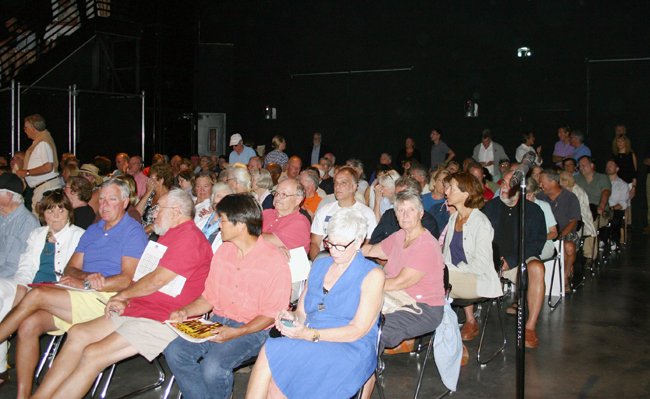East End residents pack East Hampton meeting on helicopter noise

Too low, too loud, too many.
That was the consensus from nearly 50 residents from East End communities who spoke at a packed public meeting Wednesday evening about a record number of aircraft — mostly helicopters — buzzing their homes this summer.
The East Hampton Town Board meeting held in Wainscott attracted more than 350 people, including a strong contingent of North Fork residents. Twenty-one elected officials on the town, county and state level also showed up.
When the meeting was gaveled to order in a spacious television studio near the East Hampton airport, all seats were filled and people stood two-deep in the back. More people clustered on a stairway against one wall.
The fourth public airing of grievances over excessive noise this month after meetings in Peconic, Shelter Island and Bridgehampton, this by far was the largest and most vocal.
Unlike the previous meetings, there were no Federal Aviation Administration representatives.
Southold Supervisor Scott Russell noted that Southold had passed a resolution, joining Southampton and Shelter Island, urging East Hampton not to accept Federal Aviation Admiration funds in the future, which would give more local control of the airport to the town to regulate traffic.
County Legislator Al Krupski also said he came to support East Hampton in exercising control of the airport. “The best control is local control,” Mr. Krupski said.
Residents came armed with statistics to prove they really were hearing things. According to East Hampton Airport reports, the first seven months of this year there were 12,677 take offs or landings from the airport, with helicopter traffic up 44 percent over last year. The majority of these flights pass over the North Fork and Shelter Island coming or going to the airport.
Residents from all over the East End logged 10,158 complaints by the end of July this year, compared to just 2,798 last year.
In addition to the common themes hit by nearly every speaker — negative impacts of aircraft traffic on quality of life, health and real estate values — many residents sounded a new concern: “complaint fatigue.”
That’s how Kathleen Cunningham, a director of the East Hampton-based Quiet Skies Coalition, termed it, after listening to speaker after speaker say that neither public officials or aircraft service companies are listening to them.
Ms. Cunningham said it should be noted that even though complaints have spiked, it was not an accurate count of the people who are being affected.
“I’ve stopped making phone calls,” said Margaret Skabry of Peconic, just one of many residents who said that calling a special complaint number at the East Hampton Airport is a waste of time.
But Ms. Skabry said she was re-energized by the numbers of people attending the meeting, telling the board, “You can make it happen.”
The volume of traffic to and from New York City to East Hampton has increased because of an improving economy and through phone apps and ride sharing, providing cheaper flights to the Hamptons for the weekend and trips back to the city.
East Hampton lost some control over its airport policy several years ago when the town took FAA grants, mostly to upgrade infrastructure. The town signed, “grant assurances” with the FAA, and part of that agreement was keeping the airport open to traffic around the clock throughout the year, and not to discriminate against types of aircraft using the facility.
As a result of abandoning its rights in the agreement, the door has been open to helicopter and other aircraft companies to maximize their services for clients flying in to East Hampton.
But when the grant assurances become void Dec. 31, it will be up to the East Hampton Town Board to decide to accept or reject more federal funds for airport improvements, and also debate limits for aircraft companies and services on airport use.
Speakers urged the board to reject federal funds and chart its own course.
“Helicopter companies have underestimated the will of the people,” said Jim Colligan of Shelter Island. “Quality of life issues supersede economic issues.”
The East Hampton board has acted on the issue of gaining control of the airport with a financial analysis of the facility, mainly to see if the airport could operate without FAA support.
The report states there will be “sufficient revenue from airport operations and properties to adequately service additional bonding in 2014 of at least $4.35 million and at least $5.1 million in aggregate between 2014 and 2018 (even if revenues were to decrease because of a reduction of the volume or complete elimination of helicopter operations and strict curfew approved) …”
If East Hampton refuses to take federal money and imposes restrictions on airport use and certain aircraft, litigation will almost surely follow, with aircraft service providers citing government-imposed restraints of free trade.
But Peter Wolf, a city planner and author, told the board that threats of litigation shouldn’t affect the board’s decision to act.
“Don’t worry about lawsuits if you’re on the right side,” Mr. Wolf said.






